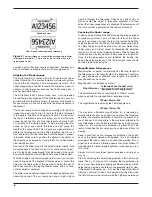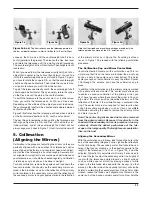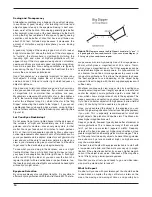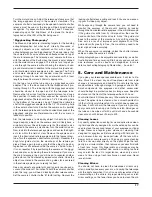
17
Turn the motor drive on. Adjust the telescope’s focuser so that
the image appears sharp in the camera’s viewfinder. The
camera’s shutter is now ready to be opened. A remote shutter
release must be used or the image will be blurred beyond
recognition. Try exposure times between 1 and 10 seconds,
depending upon the brightness of the planet to be pho-
tographed and the ISO of the film being used.
“Piggybacking Photography”
The Moon and planets are interesting targets for the budding
astrophotographer, but what next? Literally thousands of
deep-sky objects can be captured on film with a type of
astrophotography called “piggybacking”. The basic idea is that
the camera with its own camera lens attached rides on top of
the main telescope. The telescope and camera both move
with the rotation of the Earth when the mount is polar aligned
and the motor drive is engaged. This allows for a long expo-
sure through the camera without having the object or back-
ground stars blurred. In addition to the motor drive (dual-axis),
and illuminated reticle eyepiece is also needed. The T-ring
and camera adapter are not needed, since the camera is
exposing through its own lens. Any camera lens with a focal
length between 35mm and 400mm is appropriate.
On the top of one of the tube rings is a piggyback camera
adapter. This is the black knob with the threaded shaft pro-
truding through it. The tube ring with the piggyback adapter
should be closest to the open end of the telescope tube.
Remove the tube rings from the equatorial mount and swap
their position if necessary. Now, connect the camera to the
piggyback adapter. There should be a 1/4"-20 mounting hole
in the bottom of the camera’s body. Thread the protruding
shaft of the piggyback adapter into the 1/4"-20 mounting hole
in the camera a few turns. Position the camera so it is parallel
with the telescope tube and turn the knurled black knob of the
piggyback adapter counter-clockwise until the camera is
locked into position.
Aim the telescope at a deep-sky object. It should be a fairly
large deep-sky object, as the camera lens will likely have a
wide field of view. Check to make sure that the object is also
centered in the camera’s viewfinder. Turn the motor drive on.
Now, look into the telescope’s eyepiece and center the bright-
est star within the field of view. Remove the eyepiece and
insert the illuminated reticle eyepiece into the focuser draw-
tube. Turn the eyepiece’s illuminator on (dimly!). Recenter the
bright star (guide star) on the crosshairs of the reticle eye-
piece. Check again to make sure that the object to be pho-
tographed is still centered within the camera’s field of view. If
it is not, recenter it by repositioning the camera on the piggy-
back adapter, or by moving the main telescope. If you move
the main telescope, then you will need to recenter another
guide star on the illuminated eyepiece’s crosshairs. Once the
object is centered in the camera and a guide star is centered
in the reticle eyepiece, you’re ready to shoot.
Deep sky objects are quite faint, and typically require expo-
sures on the order of 10 minutes. To hold the camera’s shutter
open this long, you will need a locking shutter release cable.
Set the camera’s shutter to the “B” (bulb) setting. Depress the
locking shutter release cable and lock it. You are now expos-
ing your first deep-sky object.
While exposing through the camera lens, you will need to
monitor the accuracy of the mount’s tracking by looking
through the illuminated reticle eyepiece in the main telescope.
If the guide star drifts from its initial position, then use the
hand controller of the motor drive to “move” the guide star
back to the center of the crosshairs. Any drifting along the
Dec. axis is a result of improper polar alignment, so if the
guide star drifts greatly in Dec., the mount may need to be
polar aligned more accurately.
When the exposure is complete, unlock the shutter release
cable and close the camera’s shutter.
Astrophotography can be enjoyable and rewarding, as well as
frustrating and time-consuming. Start slowly and consult out-
side resources, such as books and magazines, for more
details about astrophotography. Remember … have fun!
8. Care and Maintenance
If you give your telescope reasonable care, it will last a life-
time. Store it in a clean, dry, dust-free place, safe from rapid
changes in temperature and humidity. Do not store the tele-
scope outdoors, although storage in a garage or shed is OK.
Small components like eyepieces and other accessories
should be kept in a protective box or storage case. Keep the
dust cover on the front of the telescope when not in use.
Your AstroView 6 EQ requires very little mechanical mainte-
nance. The optical tube is steel and has a smooth painted fin-
ish that is fairly scratch-resistant. If a scratch does appear on
the tube, it will not harm the telescope. If you wish, you may
apply some auto touch-up paint to the scratch. Smudges on
the tube can be wiped off with a soft cloth and a household
cleaner such as Windex or Formula 409.
Cleaning Lenses
Any quality optical lens cleaning tissue and optical lens clean-
ing fluid specifically designed for multi-coated optics can be
used to clean the exposed lenses of your eyepieces or finder
scope. Never use regular glass cleaner or cleaning fluid
designed for eyeglasses. Before cleaning with fluid and tis-
sue, however, blow any loose particles off the lens with a
blower bulb or compressed air. Then apply some cleaning
fluid to a tissue, never directly on the optics. Wipe the lens
gently in a circular motion, then remove any excess fluid with
a fresh lens tissue. Oily fingerprints and smudges may be
removed using this method. Use caution; rubbing too hard
may scratch the lens. On larger lenses, clean only a small
area at a time, using a fresh lens tissue on each area. Never
reuse tissues.
Cleaning Mirrors
You should not have to clean the telescope’s mirrors very
often; normally once every year or so. Covering the telescope
with the dust cover when it is not in use will prevent dust from
accumulating on the mirrors. Improper cleaning can scratch
mirror coatings, so the fewer times you have to clean the mir-
Summary of Contents for AstroView 6 EQ 9827
Page 19: ...19 ...





























